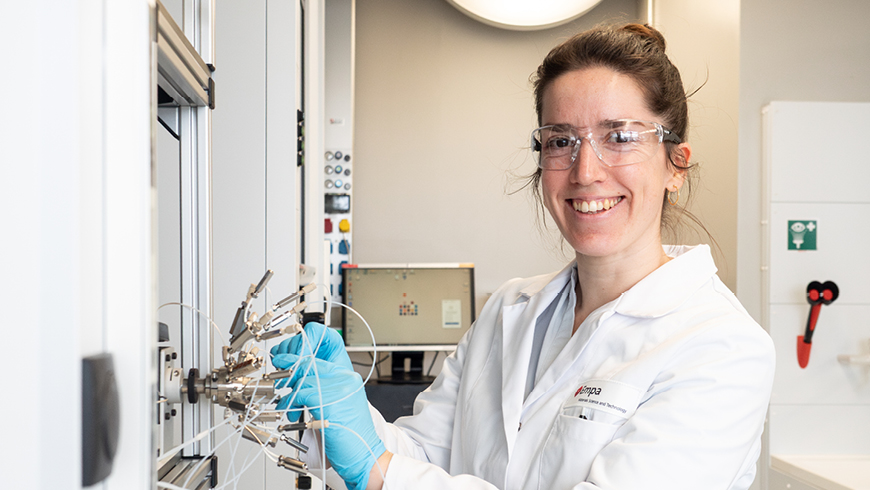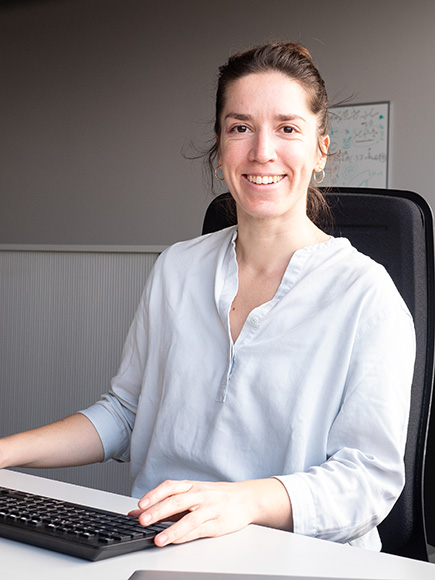Empa Young Scientist Fellowship
Synthetic fuels and more thanks to machine learning
Turning carbon dioxide into valuable substances: That is the goal of Empa researcher Carlota Bozal-Ginesta. In her research project, she wants to combine machine learning and high-throughput experiments to develop better electrodes for CO2 electrolysis. For this, she has now been awarded the two-year Empa Young Scientist Fellowship.

Accumulated carbon dioxide in the atmosphere is the main driver of climate change. But it also has the potential to be a valuable raw material. If we filter CO2 out of the atmosphere or capture it at its point of origin, it can be used to produce synthetic fuels and useful chemicals. In addition to the carbon dioxide, all that is needed is water, electricity from renewable sources and an electrolyzer with a catalyst.
This presents a challenge, though: Although today's catalysts for this process are effective, they are not specific enough. As a result, the electrolysis produces a mixture of up to 20 different liquid and gaseous compounds, which are difficult and costly to separate. The development of suitable technologies that specifically deliver one or only a few products is therefore an important research goal – at Empa and elsewhere.
Carlota Bozal-Ginesta from Empa's Materials for Energy Conversion laboratory is pursuing an innovative approach to develop better electrodes for CO2 electrolysis. She wants to characterize the influence of the electrode structure on the composition of the products using machine learning (ML). For her project, she has just been awarded a two-year Empa Young Scientist Fellowship.
A question of structure

The most common electrodes used in CO2 electrolysis are gas diffusion electrodes. These are porous structures that are coated with the active catalyst material – usually copper or silver. The shape, arrangement and density of the pores can influence the results of the catalysis. However, it is not yet clear exactly how they do this.
This is what Bozal-Ginesta has set out to change. To do so, she is combining two things: machine learning and the high-throughput system for research into CO2 electrolysis, which was established in the Materials for Energy Conversion laboratory (to the article). “To use ML, you need large data sets,” explains the researcher. The system, which can characterize eight to ten catalyst candidates simultaneously, is the key to this. Bozal-Ginesta plans to combine the resulting data with various microscopy and spectroscopy methods.
Machine learning will be used in three different ways. “First, I want to understand the correlation between the structure of the electrode and its electrochemical performance. Secondly, I want to develop ML-based tools that can identify useful structural features in microscopy images of the electrodes. And finally, I want to use this data to derive realistic new electrode structures that could have promising properties,” explains the researcher.
Bozal-Ginesta is particularly mindful to use the ML technology in a responsible fashion. “Machine learning and artificial intelligence are often used in a 'brute force approach' – with limited data curation and little consideration of existing knowledge,” she explains. If the data set is incomplete or the models are inaccurate, the results will be misleading. “It is still up to us, the scientists, to formulate hypotheses and set priorities, i.e. propose and validate which information matters most in performance modelling and prediction. ML is a powerful tool for testing our hypotheses. But only we can decide what's really important,” Bozal-Ginesta is convinced.
Talent promotion at Empa
The Empa Young Scientist Fellowship is a funding program for exceptionally talented young scientists. Fellows receive funding to carry out an independent research project for a period of two years. Fellowships are awarded in a competitive process to select the most promising projects.
Dr. Carlota Bozal-Ginesta
Materials for Energy Conversion
Phone +41 58 765 42 93
- Empa Fellowships
- Synthetic fuels and chemicals from CO₂: Ten experiments in parallel
- Empa Young Scientist Fellowship: Young researcher sheds light on quantum molecules
- Empa Young Scientist Fellowship: When disorder helps solve our energy problems
- Empa Young Scientist Fellowship: Efficient radiation therapy thanks to nanoparticles
-
Share






